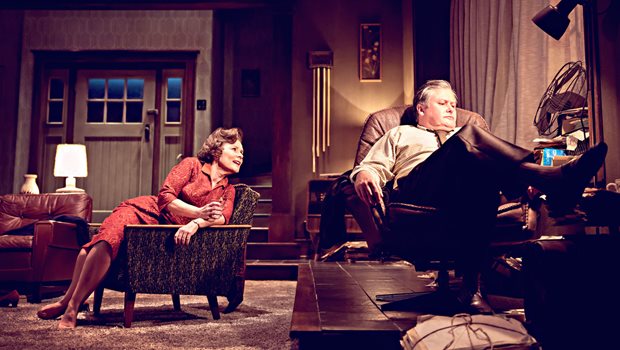Venue: The Harold Pinter Theatre
Written by Edward Albee
Directed by James MacDonald
Being sat up in the Gods has its benefits. Especially in the case of Edward Albee’s 20th century classic, where a sole set sits stoically for the three-hour, behemoth duration. A God’s-Eye view of James MacDonald’s version of ‘…Virginia Woolf?’ also seems especially fitting. George (Conleth Hill) and Martha’s (Imelda Staunton) living room is squared off by chequered tiles, leaving a sunken shag-pile carpet section in the centre. As the sadomasochistic couple drive needles into each other’s soft spots like pin-cushions, their marital parlour games appear like orchestrated manoeuvres: as in Chess, or ‘total war’ as George puts it. The people/pieces reveal their moves from above. Here, battle-lines are drawn in lino and the shagpile-square-cum-sparring-pit.
The 60s living room with doll-house figures striding about it calls to mind David Lynch’s Rabbits. And there’s a Lynchian quality to seeing Albee’s masterpiece with a live audience, whose laughter becomes more unsteady as the piece plunges deeper into cruelty and trauma. It begins to sound like a laugh-track gone wrong; ill-timed, individual members singled out. MacDonald’s version is a particularly funny one, making the break from drinks-party to deathly lament in Act Three even more jolting.
‘[George] made the hideous, the hurting, the insulting mistake of loving me, and must be punished for it.’
Martha, Who’s Afraid of Virginia Woolf?
Another curiosity of sitting in the highest circle: you’re afforded a privileged view of some characters’ most exposed moments. E.g. Laments to a Godless sky, profiles of relaxing reclines on the sofa, floored drunken splay-outs like crime scene murder outlines. Despite there being only four characters, the number of caricatures, wall-to-wall dialogue and sheer decibel-ic intensity ensures the room always feels full.
Of the two married pairs, it’s the elder who steal the show. Staunton bestows an animalistic desperation to Martha’s ‘braying’. Despite having Bouffant hair à la Liz Taylor, she foregoes glamour. She truly ‘busts a gut’, ‘howls it out’; George’s remarks on her claws and brute strength barely seem like exaggerations. Staunton peacock-struts about the stage like an ADHD meth-addict gone cold turkey. Her voice must be ravaged by the end (how does she do this every night?): she drags it through high pitches of peril, mockery and fury. There’s a mirthless edge hidden deep within her laughter. Her almost schizophrenic switches in character give Staunton full-reign in range-deployment. One minute she’s croak-cooing in childish baby-talk, the next minute banshee-screaming, before morphing into chaise-longue seductress. Oh, and her soliloquy at the beginning of Act Three is an absolute knock-out (cueing up pin-drop silence from the previously riotous crowd).
‘we take our tears, and we put ‘em in the icebox […] and then we put them in our drinks.’
– Martha, Who’s Afraid of Virginia Woolf?
How to compete with that? Conleth Hill as George does a pretty good fucking job. His voice is like a cross between Alfred Molina and Bradley Whitford in The West Wing. At times, his hunched gait and crumpled suit – coupled with some ill-informed pontificating – conjures a more depressing version of Ed Balls, or a pouting Trump in a world where he had no inheritance with which to bleach himself upon public life. Hill brings a slapstick comedy to George that I’ve not seen before. His dramatic handball swings, elaborate arm crosses and mime-like posturing give George a clownish physicality, embodying his wife’s insult-moniker.
George’s clowning soon loses its lightness of course, his faux-playful snapdragons aimed at Martha standing in for poison-darts. Their home in New Carthage burns down just like the old colony. This is a slow-mo car crash, where the audience’s rubbernecks are held by a ceaseless brace. It is exhausting enough to watch – performing it must come with a real risk of ‘busting a gut’.

